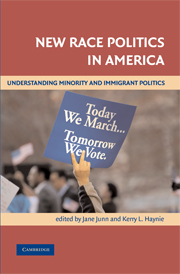Book contents
- Frontmatter
- Contents
- Contributors
- Acknowledgments
- 1 New Race Politics: The Changing Face of the American Electoral Landscape
- 2 In Whose Interest? Political Parties, Context, and the Incorporation of Immigrants
- 3 Beyond Black and White: The Experiences and Effects of Economic Status among Racial and Ethnic Minorities
- 4 Activity amid Diversity: Asian American Political Participation
- 5 Get Me to the Polls on Time: Coethnic Mobilization and Latino Turnout
- 6 Se Habla Espanol: Ethnic Campaign Strategies and Latino Voting Behavior
- 7 Structuring Group Activism: A Macro Model of Black Participation
- 8 Black Elites and Latino Immigrant Relations in a Southern City: Do Black Elites and the Black Masses Agree?
- 9 Understanding the New Race Politics: Conclusions and Challenges
- References
- Index
6 - Se Habla Espanol: Ethnic Campaign Strategies and Latino Voting Behavior
Published online by Cambridge University Press: 05 September 2012
- Frontmatter
- Contents
- Contributors
- Acknowledgments
- 1 New Race Politics: The Changing Face of the American Electoral Landscape
- 2 In Whose Interest? Political Parties, Context, and the Incorporation of Immigrants
- 3 Beyond Black and White: The Experiences and Effects of Economic Status among Racial and Ethnic Minorities
- 4 Activity amid Diversity: Asian American Political Participation
- 5 Get Me to the Polls on Time: Coethnic Mobilization and Latino Turnout
- 6 Se Habla Espanol: Ethnic Campaign Strategies and Latino Voting Behavior
- 7 Structuring Group Activism: A Macro Model of Black Participation
- 8 Black Elites and Latino Immigrant Relations in a Southern City: Do Black Elites and the Black Masses Agree?
- 9 Understanding the New Race Politics: Conclusions and Challenges
- References
- Index
Summary
Latinos in the United States have been described as a sleeping giant in electoral politics because of their relatively low voting rates compared to their share of the population. The electoral significance of this diverse group of Americans is a function not only of its size, but also its concentration in states with large U.S. congressional delegations and correspondingly hefty Electoral College votes. If the giant awakens, the Latino electorate has the potential to become a major influence in national electoral politics. The major parties have taken notice of the demographic trends, and in recent presidential elections they have started to make efforts to court the “Latino vote” (Garcia 2003). Political campaigns utilize a variety of voter outreach strategies, but television advertising has become the most important and ubiquitous technique of political communications in modern political campaigns. Latinos are beginning to figure more prominently in national campaign media strategies (Buehler 1977; Doherty and Cully Anderson 2003; Subervi-Velez and Connaughton 1999), and in the 2000 presidential election over three thousand political advertisements were aired in Spanish.
The development of strategies aimed at Latino voters is still in its infancy, complicated by the newness and diversity of the Latino population in the United States. Indeed, nearly half of Latinos are immigrants whose first language is most likely not English. Furthermore, there is substantial internal ethnic diversity within the Latino category in terms of country of origin.
- Type
- Chapter
- Information
- New Race Politics in AmericaUnderstanding Minority and Immigrant Politics, pp. 114 - 129Publisher: Cambridge University PressPrint publication year: 2008
- 5
- Cited by



